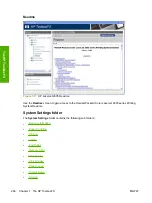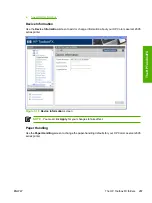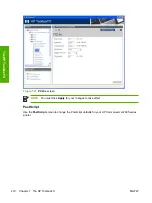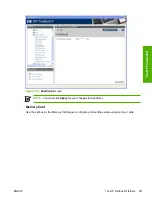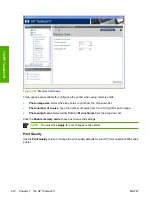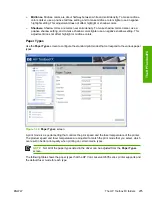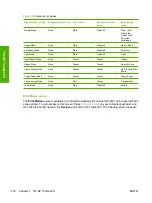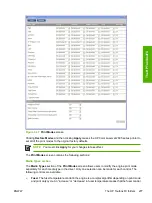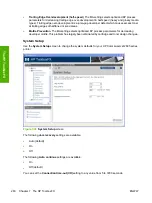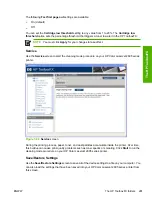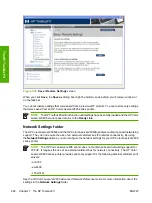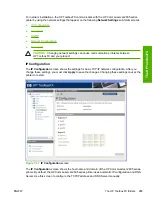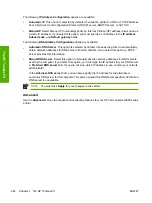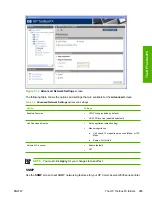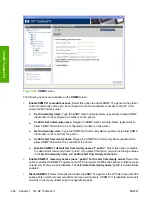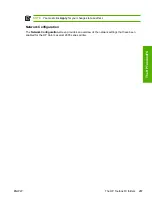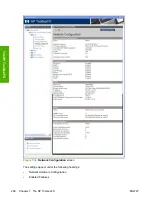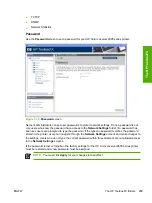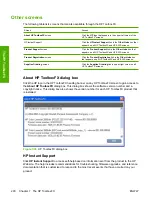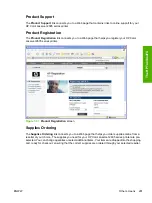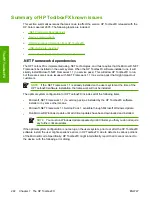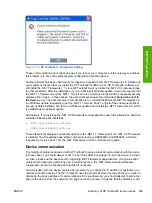
show a transfer defect while the simplex side does not. These adjustments allow duplex-side
defects to be improved without affecting transfer performance on the simplex side (or vice versa).
The following settings are available for the
Duplex Transfer
control.
●
Dry paper
. This setting increases transfer bias. Some papers (notably Chinese papers)
become highly resistive in dry environments. To get enough transfer current into the paper to
have good transfer, the transfer bias voltage needs to be increased. The range of paper
resistivity in low humidity is so wide that a single standard engine print mode cannot cover all
the cases.
●
Humid paper
. This setting decreases transfer bias. All papers absorb water at higher
humidities and become electrically less resistive. This results in transfer defects caused by
too much transfer current. The engine has a humidity sensor and also checks the conductivity
of the ETB in order to estimate the humidity of the media, but this can be inadequate in more
extreme cases.
●
Rough paper This setting increases transfer current. Rough papers such as cotton bond
papers have a large portion of their surface area spaced away from contact with the OPC
drum by their surface texture. In this case, more transfer current is required.
●
Less/More transfer (-2, -1, +1, +2)
. These settings provide two levels of decreased transfer
bias voltage and two levels of increased transfer bias voltage in case the above adjustments
aren’t enough. They can be used to “hunt” for the best setting. In extreme case (very dry or
very wet), low transfer current defects and high transfer current defects can overlap. That is,
there won’t be a defect free setting. These adjustments can help find the best operating point.
●
Toner
. This adjustment is applied by the formatter.
The following settings are available for the
Toner
control.
●
Less toner (-1, -2, -3)
. These settings decrease the maximum primary toner amount for each
color (CMYK) from 100% to 95%, 90% and 85%, respectively. This is useful for fixing toner
scatter on high-resisitivity papers in low humidity environments.
●
Discharge
. The following settings are available for the
Discharge
control.
●
On/Off
. The HP Color LaserJet 2605 series printer has an electrostatic discharge brush right
where the paper separates from the ETB (before the fuser). This prevents toner scatter due
to sudden paper discharge. For extreme cases, it could make things worse, so this setting is
provided to turn the discharge brush off.
Optimize section
The
Optimize
settings are applied to all media printed depending on the engine’s internal tables. The
following controls are available:
●
Background Toner
. The
On
setting selects optimized EP process parameters for reducing
background on glossy paper.
●
Extra Cleaning
. High acid content or “talc” papers tend to leave a conductive residue on the OPC
drums. The
On
setting turns on increased OPC/ETB cleaning rotations before and after pages are
printed to help rub off this residue.
●
Trailing Edge Over-development (full-speed)
. The
On
setting selects optimized EP process
parameters for decreasing trailing edge over-development in full speed (Light and Plain media
types). Trailing edge over-development is a jump-gap developer defect which causes excess toner
at trailing edges of halftoned or solid areas.
ENWW
The HP ToolboxFX folders
279
T
h
e HP ToolboxF
X
Summary of Contents for 2605dtn - Color LaserJet Laser Printer
Page 1: ...HP Color LaserJet 2605 2605dn 2605dtn Software Technical Reference ...
Page 2: ......
Page 3: ...HP Color LaserJet 2605 series Software Technical Reference ...
Page 15: ...Index 335 ENWW xiii ...
Page 16: ...xiv ENWW ...
Page 18: ...xvi ENWW ...
Page 24: ...xxii ENWW ...
Page 34: ...10 Chapter 1 Purpose and scope ENWW Purpose and scope ...
Page 72: ...48 Chapter 2 Software overview for Windows ENWW Software overview for Windows ...
Page 208: ...184 Chapter 5 Windows HP PCL 6 Unidriver features ENWW Windows HP PCL 6 Unidriver features ...
Page 349: ...Figure 8 22 HP EWS Password page ENWW HP Embedded Web Server 325 Engineering Detail ...
Page 358: ...334 Chapter 8 Engineering Detail ENWW Engineering Detail ...
Page 370: ...346 Index ENWW ...
Page 371: ......
Page 372: ... 2006 Hewlett Packard Development Company L P www hp com ...


